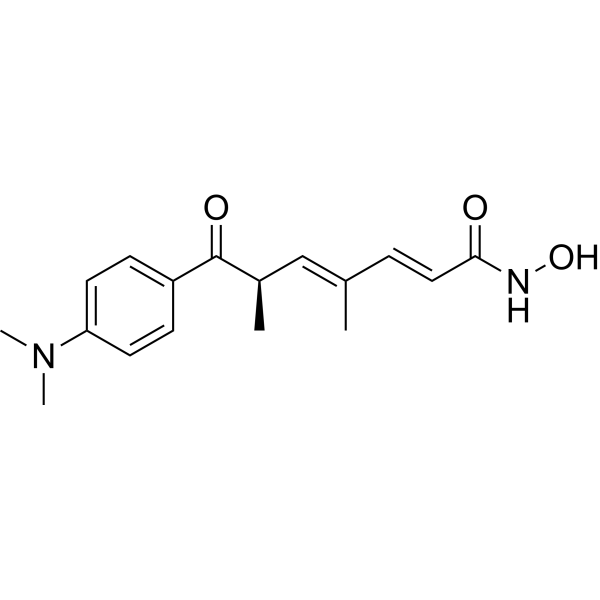Home
Products
Trichostatin A



| Product Name | Trichostatin A |
| Price: | Inquiry |
| Catalog No.: | CN00524 |
| CAS No.: | 58880-19-6 |
| Molecular Formula: | C17H22N2O3 |
| Molecular Weight: | 302.4 g/mol |
| Purity: | >=98% |
| Type of Compound: | Alkaloids |
| Physical Desc.: | Powder |
| Source: | |
| Solvent: | Chloroform, Dichloromethane, Ethyl Acetate, DMSO, Acetone, etc. |
| SMILES: | ONC(=O)/C=C/C(=C/[C@H](C(=O)c1ccc(cc1)N(C)C)C)/C |
| Contact us | |
|---|---|
| First Name: | |
| Last Name: | |
| E-mail: | |
| Question: | |
| Description | Trichostatin A is a potent and specific inhibitor of HDAC class I/II, with an IC50 value of 1.8 nM for HDAC. |
| Target | HDAC:1.8 nM (IC50) |
| In Vitro | Trichostatin A is a potent and specific inhibitor of HDAC class I/II, with an IC50 value of 1.8 nM for HDAC. Trichostatin A (TSA) inhibits proliferation of eight breast carcinoma cell lines with mean±SD IC50 of 124.4±120.4 nM (range, 26.4-308.1 nM). HDAC inhibitory activity of Trichostatin A is similar in all cell lines with mean IC50 of 2.4±0.5 nM (range, 1.5-2.9 nM)[1]. Trichostatin A (330 nM) increases Gαs protein expression in human myometrial cells, but does not increase Gαs mRNA levels[2]. Trichostatin A (20-75 nM) induces minimal cytotoxicity to adipose-derived stem cells (ADSCs), and enhances the osteogenic differentiation capacity of ADSCs[3]. In addition, Trichostatin A (0, 10, 100, 500 nM) dose-dependently decreases HDAC class I/II activity[4]. |
| In Vivo | Trichostatin A (500 μg/kg, s.c.) pronounces antitumor activity without causing any measurable toxicity in doses of up to 5 mg/kg by s.c. injection, in randomized controlled efficacy studies using the N-methyl-N-nitrosourea carcinogen-induced rat mammary carcinoma model[1]. |
| Cell Assay | Cells are cultured in a 96-well plate at 1×103 cells per well with 100 μL complete DMEM in the presence or absence of a HDAC inhibitor Trichostatin A for 72 h. Cytotoxicity is measured by performing WST-8 assay using a CCK-8 cell proliferation kit. The 450 nm absorbance is measured with a microplate reader. All experiments are carried out in triplicate and 3 independent experiments are performed[3]. |
| Animal Admin | Rats[1] Twelve rats are randomized to receive 500 μg/kg Trichostatin A in 50 μL DMSO, or 50 μL DMSO as vehicle control, by s.c. injection twice weekly for 4 weeks. In subsequent studies, 30 rats are randomized to receive Trichostatin A 500 μg/kg in 50 μL DMSO, or 50 μL DMSO as vehicle control, by s.c. injection daily for 4 weeks. Weekly tumor measurements, estimated tumor volumes, and body mass are recorded for each animal. Animals are sacrificed at the end of the 4-week study period; palpable tumors are resected and immediately snap-frozen in liquid nitrogen. Animals with tumors <2 cm in diameter or ulcerating tumors are withdrawn from study[1]. |
| Density | 1.1±0.1 g/cm3 |
| Exact Mass | 302.163055 |
| PSA | 69.64000 |
| LogP | 2.77 |